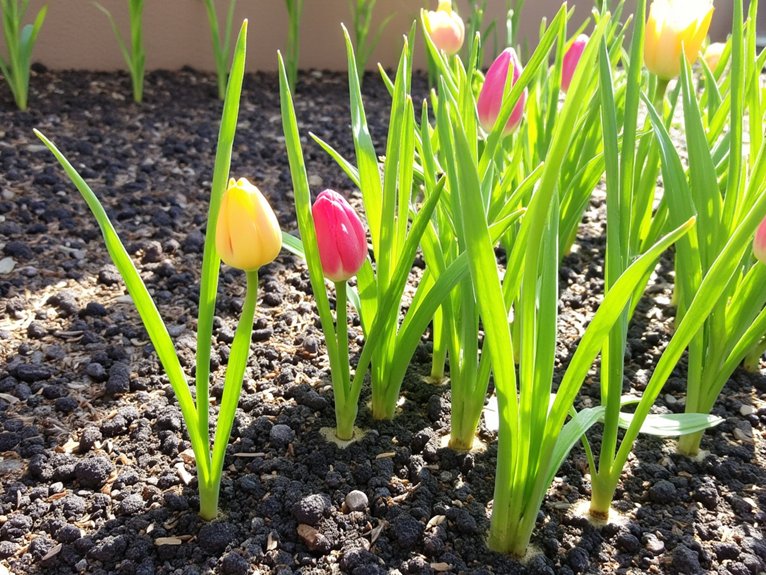Growing tulips in containers enables gardeners to bring vibrant spring color to patios, porches, and small spaces. According to horticulturist Dr. Sarah Chen, “Container tulips require specific conditions to thrive, but the results are worth the effort.” Success depends on selecting proper containers, timing the fall planting correctly, and maintaining ideal growing conditions throughout winter dormancy. These fundamental steps lay the groundwork for spectacular spring displays that even novice gardeners can achieve.
Contents
Essential Planning Steps for Container Tulips

Success with container tulip gardening begins with careful planning several months before the desired spring blooms appear. Fall planting, typically in October or November, provides the essential cold period tulips need for spring flowering.
When selecting bulb varieties, gardeners should focus on shorter-stemmed types like Double Early or Triumph tulips, which resist wind damage in containers. “Choose firm, large bulbs without blemishes from reputable suppliers,” advises horticulturist Sarah Chen.
For best results, create a timeline starting in late summer: order bulbs by September, prepare containers in early October, and complete planting before the first frost arrives.
Selecting the Perfect Container and Bulbs
With the gardening timeline established, proper container selection stands as the foundation for healthy tulip growth. Experts recommend terracotta or ceramic container materials for ideal insulation and drainage, with minimum dimensions of 12 inches in both width and height. Multiple drainage holes prevent waterlogging and root rot.
When selecting bulb varieties, focus on shorter-stemmed types like Double Early, Kaufmanniana, and Triumph tulips. These varieties resist wind damage and perform exceptionally well in containers. Choose firm, large bulbs free from blemishes, sourcing from reputable growers to guarantee vibrant spring blooms.
Proper Planting Techniques for Success

Once the right container and bulbs have been selected, precise planting depth and positioning become essential factors for successful tulip growth. The ideal bulb depth should be twice the height of each bulb, though slightly shallower in containers than in garden soil.
For peak growth, gardeners should position bulbs with their pointed ends facing upward and flat sides oriented outward. Working from the center outward, bulbs should be spaced 1-2 inches apart without touching. This arrangement allows proper root development while maximizing the number of tulips that can flourish in the container space.
Winter Care and Chilling Requirements
After proper bulb planting, the winter chilling period serves as a defining phase in tulip development. Tulips require 14 weeks of temperatures around 40°F (±5°) for successful vernalization and spring blooming.
For ideal winter protection, gardeners should:
- Move containers to an unheated garage, cellar, or protected outdoor area
- Cluster pots together if keeping outdoors
- Apply 2-3 inches of mulch around containers
- Check soil moisture every 2 weeks
- Guarantee consistent temperature without extreme fluctuations
“The chilling duration is non-negotiable for tulips,” notes horticulturist Dr. Sarah Chen. “Without proper cold exposure, bulbs won’t produce flowers.”
Spring Growth and Blooming Care

The magical transformation from dormant bulbs to vibrant blooms begins as spring temperatures consistently reach above 45°F. Gardeners must monitor soil moisture carefully, implementing a consistent spring watering schedule that maintains even dampness without waterlogging the containers.
For ideal growth, inspect plants weekly for signs of pest damage or disease. Common issues include aphids and fungal infections. Remove affected foliage immediately and treat with appropriate remedies. Master gardener Sarah Chen advises, “Watch for yellowing leaves or deformed stems, which signal potential problems requiring immediate attention.”
Position containers in full sun, rotating them periodically to guarantee even growth as stems emerge.
Post-Bloom Maintenance and Storage
While tulip blooms bring vibrant spring color, proper post-bloom care determines the bulbs’ future health. Allow foliage care to continue until leaves naturally yellow and die back, typically 6-8 weeks after flowering ends.
Once foliage has completely browned, carefully dig up the bulbs and brush off excess soil. “Proper bulb storage requires a dry, dark environment between 60-65°F,” explains botanist Dr. Sarah Chen. Store cleaned bulbs in paper bags or mesh containers with adequate air circulation.
Label varieties and planting depths for fall replanting. Check stored bulbs monthly, discarding any that show signs of rot or mold.
